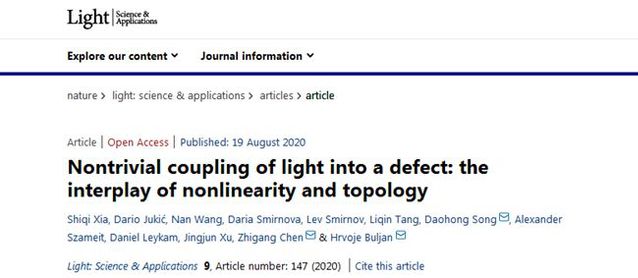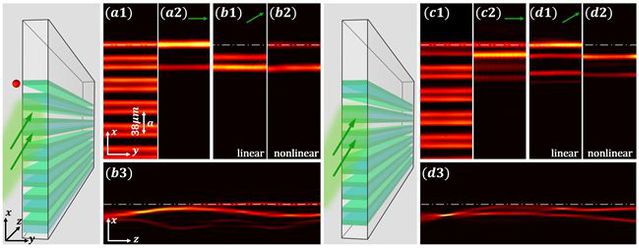Nankai University Makes Important Progress in the Field of Nonlinear Topological Photonics

Recently, a research group led by NKU’s Prof. Zhigang Chen and Prof. Jingjun Xu cooperated with the team of Prof. Hrvoje Buljan from University of Zagreb, Croatia, and made important progress in the field of Nonlinear Topological Photonics. Based on one-dimensional (1D) Su Schrieffer Heeger (SSH) lattices, they experimentally and theoretically studied the nonlinear interaction between light and topological optical microstructures. They demonstrated nonlinearity-induced coupling of light into topologically protected edge states using a photonic platform and developed a general theoretical framework for interpreting the mode-coupling dynamics in nonlinear topological systems. The result has been published on “Light: Science & Applications” with the title “Nontrivial coupling of light into a defect: the interplay of nonlinearity and topology”.
In these years, Topological Photonics is one of the most active and emerging research fields in Optics. Topology is a mathematical concept introduced to better understand basic physical phenomena such as the quantum Hall effect (QHE). It successfully explained the QHE and promoted the development of topological insulators. When two materials with different topological invariants are interfaced, bulk-edge correspondence guarantees the existence of topological edge states, which enjoy robust unidirectional propagation. Such correspondence holds in both quantum and classical wave systems, because topological concepts can be used to describe the properties of band structures. With the first observation of the unidirectional propagation of electromagnetic waves in the microwave regime in 2009, topological insulators, topological states of light and related phenomena were later realized in various systems, including photonic lattices, ring resonators and metamaterials. Thus, topological photonics - an ascendant branch of photonics - has been successfully established.
At present, due to some experimental and theoretical difficulties, most of the research work of topological photonics focuses on linear topological effects. However, the introduction of nonlinear effects may bring about many novel physical phenomena. For example, in electronic systems, the interplay of topology and quantum many-body interactions can result in intriguing topological states of matter such as the fractional QHE. In the photonic system, the introduction of nonlinearity effects not only can produce new phenomena such as topological optical soliton and nonlinear-induced optical topological phase transition, but also can realize new applications such as nonlinear topological frequency conversion and topological laser. Although some progress has been made in the field of nonlinear topological photonics, there is still a blank space regarding the coupling of nonlinear and topological eigenstates and physical mechanism related to the interaction between nonlinearity and topological structure.
By using 1D SSH photonic lattice as platform, in this experiment, researchers observed that in a topologically non-trivial photonic structure, nonlinear effects are able to achieve the coupling of bulk-boundary and interface. On this base, researchers proposed a new theory of mode coupling in a topologically non-trivial system and successfully explained related experimental results. Methods mentioned in the paper provide a new research platform for studying the interaction between nonlinearity and topological structure. Based on the 1D nonlinear system, the paper introduces a protocol capable of revealing the interplay of nonlinearity and topology, which is of a general nature. The concepts are applicable to other nonlinear topological systems, both in higher dimensions and beyond the photonic platform of this experiment.

Figure: Comparison of the edge excitation between topologically trivial and nontrivial SSH lattices. The two illustrations show the tilted excitation (green arrows) for nontrivial (left) and trivial (right) lattices and simulation results (below)
The first corresponding unit of this research activity is Nankai University. Nankai University’s doctoral students Shiqi Xia and Nan Wang and University of Zagreb’s Assistant Professor Dario Jukić are the first authors. Nankai University’s Prof. Zhigang Chen, Vice Prof. Daohong Song and Prof. Hrvoje Buljan from University of Zagreb (also a specially appointed professor of Nankai University) are the corresponding authors. Co-operators also include Prof. Alexander Szameit from Germany and researcher Dr. Daniel Leykam from South Korea. This research is supported by the National Key R&D Program of China, the National Natural Science Foundation and others.
Link to the paper: https://www.nature.com/articles/s41377-020-00371-y
(Reported by Daohong Song, Huanyun Xia, Translated by Yuchen Shi, Edited by Davide Francolino and JianjingYun)









